Behrens Perigee: A Moon Phase Indication That’s Not Your Typical Moon Phase Indication
We live in a universe of cycles birthed from the fundamental forces of reality.
As far as we know, there are four fundamental forces of nature driving all movement and transforming all states of energy into action, the strong nuclear force, the weak nuclear force, electromagnetism, and the big daddy, gravity. The strong and weak nuclear forces hold the very fabric of reality together, working at the atomic scale, while electromagnetism is how the atomic world interacts with the macro world we live in. But gravity is what puts larger matter in motion, moving entire galaxies at speeds nearly unthinkable to our frame of reference.
This motion affects pretty much everything we ever experience because the large-scale motion of the earth is almost completely thanks to gravity. The earth would not exist without gravity, nor would the sun, which also would not convert hydrogen into light and heat that bombards the earth every second. Without gravity we would not orbit the sun, and our planet would not have the seasons, day or night, the tides, or ecosystems of life.
The water cycle, plate tectonics, and the rock cycle (yes, there is such a thing as the rock cycle), the nitrogen cycle and the carbon cycle, all support the ability of our planet to be dynamic and bear life. The long term cycles of our eccentric orbit combined with the cycles of the sun’s strength influence the glacially slow cycles that renew ecosystems and restart biomes, building a fertile ground for the next generation. Even our personal cycles of life and death, hormones, relationships, culture, technology, and so on are all influenced by gravity and the other fundamental forces.
There is a saying that the only constant is change, and every day of our lives we find that to be more and more true. Simply learning to accept that fact and move with the cycles of the world allows us to create with the ever-flowing river of energy that we are swimming in. It’s for this reason people and cultures are so wrapped up in celebrating cycles such as birthdays, the new year, the harvest, and all the holidays originally tied to astronomical events. People find comfort in cycles.
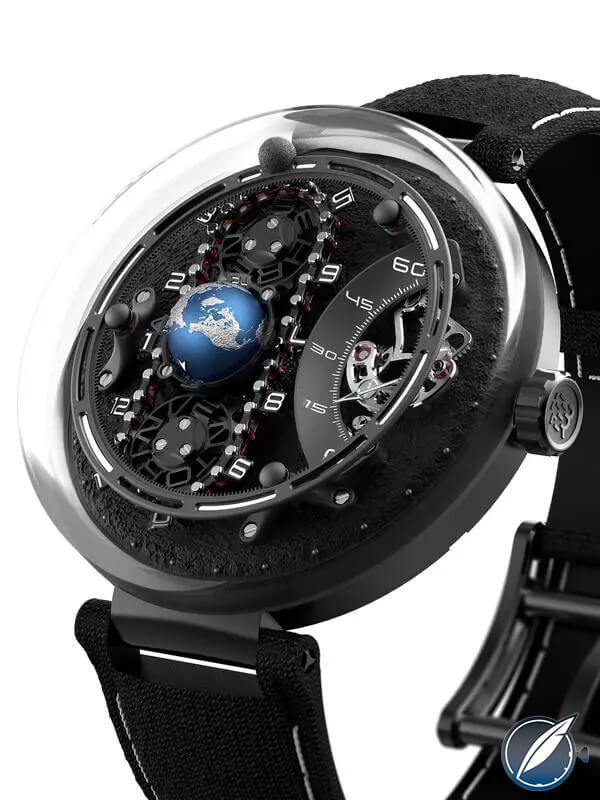
Behrens Perigee
It may be why I have always gravitated (see what I did there?) to the humble moon phase mechanism, a creation that tracks an ancient cycle born from the gravity powering everything we hold dear. As a result of this fixation, I am always on the lookout for a new take on the cycle so I was thrilled to see that the growing Chinese brand Behrens launched the Perigee with a visually arresting moon phase display.
Behrens Perigee
The Perigee is not your typical moon phase watch. In fact, you probably wouldn’t even notice the moon phase at first glance thanks to the massive hemispherical earth surrounded by a chain driving the hour display. This is easily the most visually impactful feature of the Perigee, but it is far from the whole package. On the right side of the dial is a swooping scallop, just like the Carousel corner at the Nurburgring, which tracks the minutes.
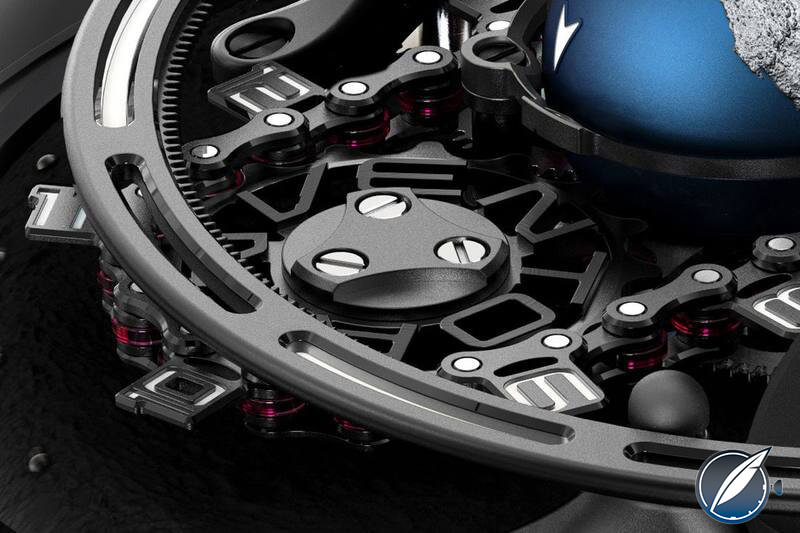
Behrens Perigee movement detail
Climbing steadily as the minutes pass, the hand and its exposed retrograde mechanism draw the eye across the dial and provide a bit of excitement as it snaps back at the top of the hour. It is only after drinking in both of the main attractions does the orbiting mini sphere of the moon become apparent, slowly circling the dial above everything. The moon is affixed to a ring which is supported by three slotted pinion gears arising from the movement below, holding the ring gear aloft and allowing it to sort of float within the tall case.
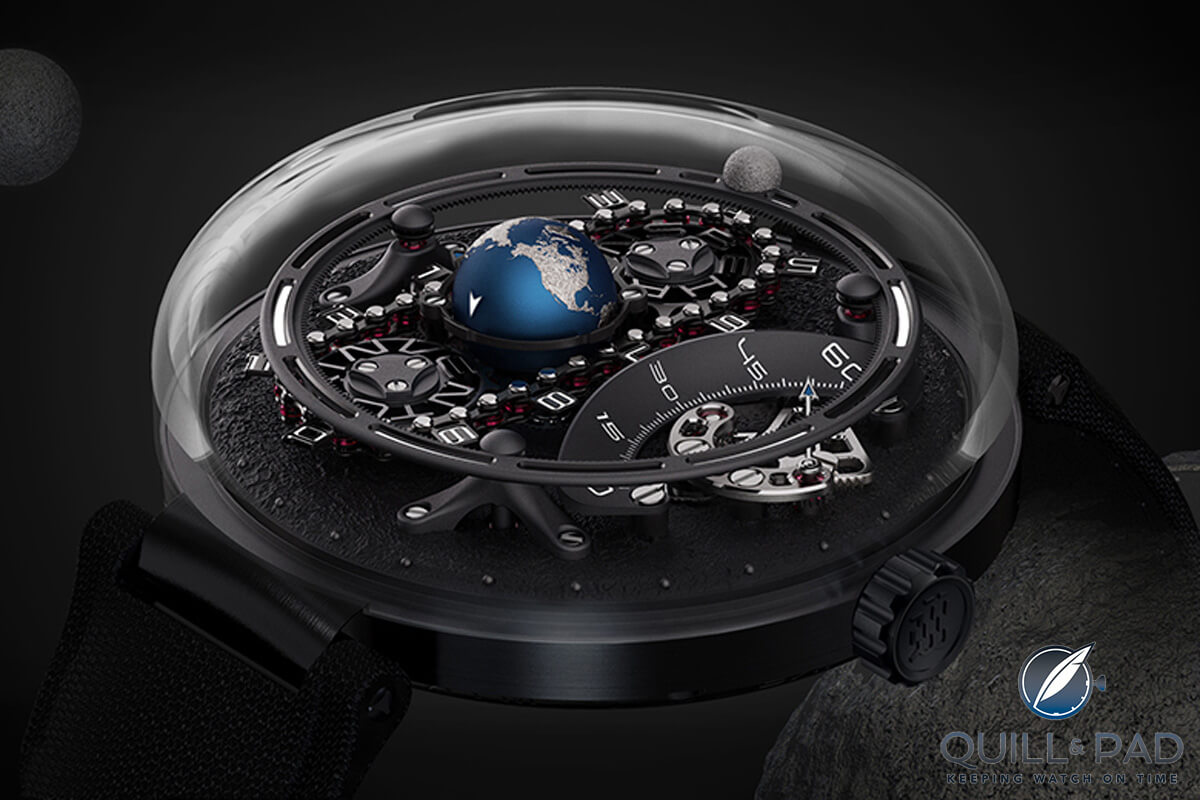
Behrens Perigee
The visible dial beneath the presentation is textured like a lunar surface, though it’s coated black to match many of the visible movement parts. All of this lies beneath an absolutely massive sapphire crystal dome giving a complete 180 degrees of visibility into the mechanism. It is a captivating display thanks to the mechanical ingenuity on offer, and it’s followed up on the rear. The caliber BM01 is designed with presentation in mind, using as much skeletonized bridge and plate construction as possible.
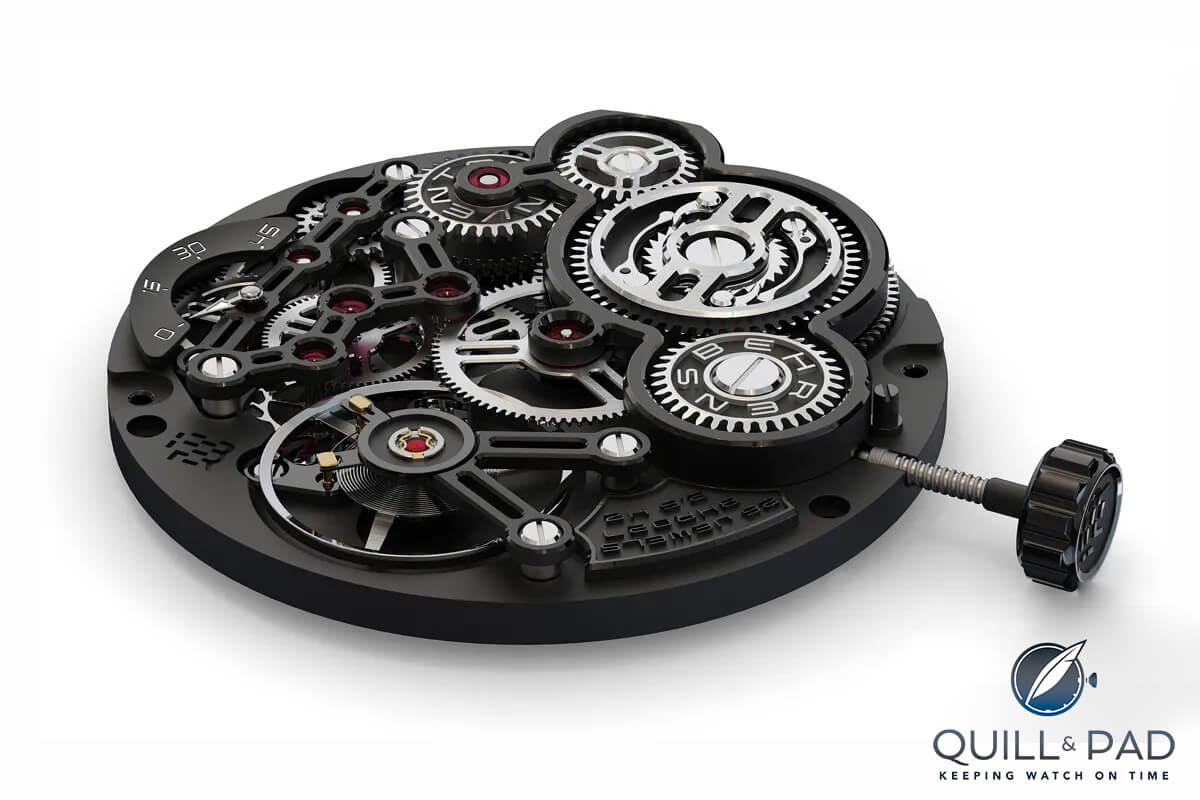
Behrens Perigee movement
Digging into mechanics
The winding mechanism is raised off the main plate above the going train, resting within a plate resembling ancient castle walls. Inside the mainspring ratchet wheel, Behrens has installed a classic double ratcheting mechanism typically found in repeater mechanisms. These are one of my favorite ratcheting mechanisms and it fits perfectly with the Perigee aesthetic. All wheels in the movement are skeletonized to match the bridges except for two that are relief engraved with Behrens and Inventor, something seen earlier on the sprockets driving the hours around front.
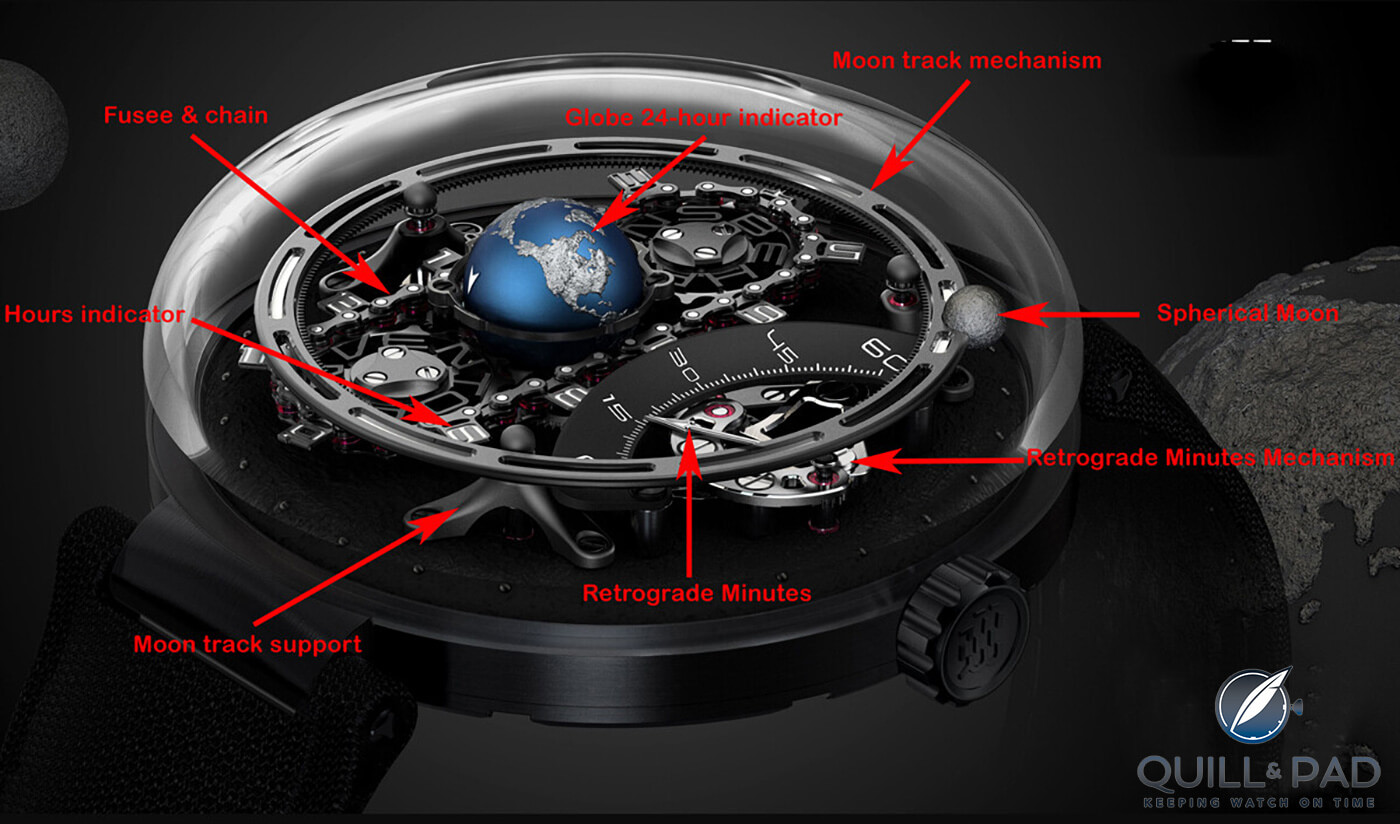
Behrens Perigee displays and mechanisms
Adding to the functionality is a power reserve indicator, positioned opposite the crown and mirroring the scalloped style of the retrograde minutes display on the front, only smaller. The entire presentation of the mechanics shows a clear throughline of execution, likely because this caliber represents the first in-house developed caliber for Behrens, which allowed them to ensure it was cohesive from front to back. It was also clear that they used it to focus even closer on their clear fascination with cycles.
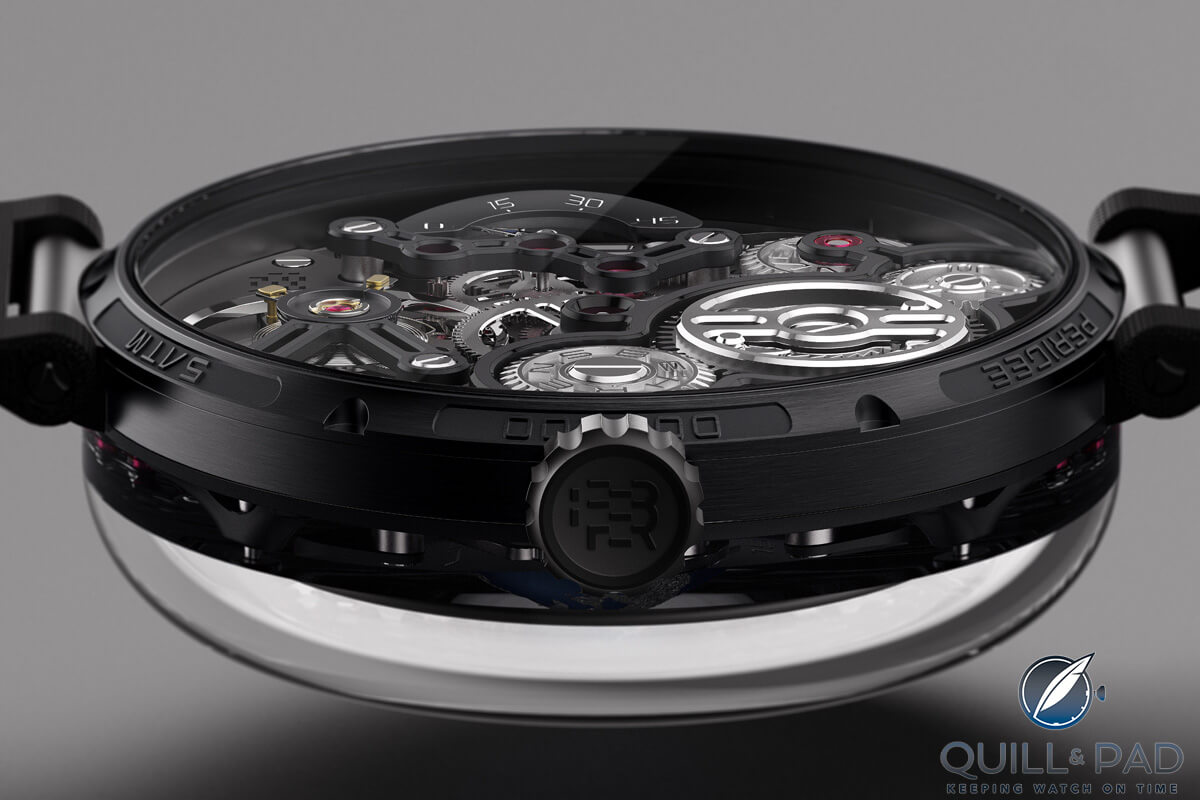
Side and back of the Behrens Perigee
Obviously, watches are all about cycles since they are essentially a bunch of gears that continuously go in circles all day, while the hands make daily cycles around the dial. But Behrens wanted to highlight how true it is that so much of the universe is part of larger cycles and the design emphasizes this. The chain for the hours uses ruby rollers and cantilevered numbers hanging off the side and is constantly moving, carrying the numbers on a twice-daily journey around the sprockets.
Cycles ground everything
This journey coincides with the spherical globe rotating once a day on its vertical axis, showing the earth from above the north pole. This 24-hour day/night indicator isn’t the longest cycle on display, that comes from the moon phase orbiting the dial.
In actuality, it isn’t a true moon phase because it doesn’t track the moon’s phases but the moon’s orbit. The time it takes to orbit the dial is 27.3 days which is the approximate length of the sidereal lunar month, or the time it takes for the moon to return to the same point compared with the stars rather than the earth.

Behrens Perigee lume shot
Since the earth is orbiting the sun, that means that the sidereal month is shorter than the synodic month (which tracks the phases) since the background stars slowly drift across the night sky all year. Therefore, the sidereal lunar month is based on the cycle of the earth-moon system in relation to the wider universe, while the phases of the moon relate to the cycle of the earth-moon-sun system.
Either way, the cycle is on clear display, reminding us that the universe keeps moving at every moment, inching (or hurtling) forward into what we understand as the future. But it all comes back to how cycles power our lives and affect our understanding of the world. Without the moon making its way around us regularly, or the sun rising and setting every day, we might not have as clear of an understanding of time. In fact, the universe might appear largely static based on our frame of reference.
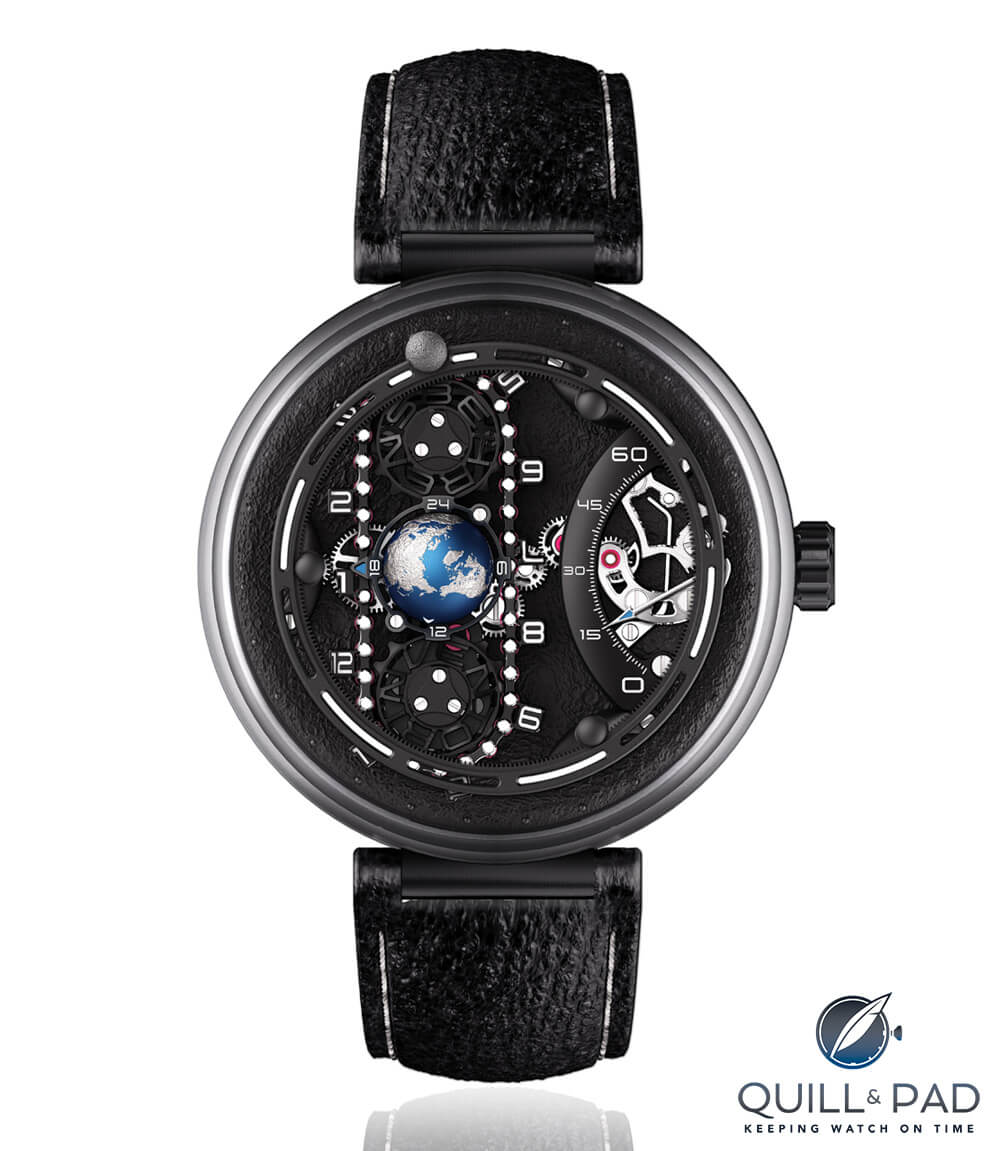
Behrens Perigee
This is true elsewhere in the universe, so we should consider ourselves lucky that we get to experience the consistent and repeated change that these universal cycles bring to us. The cycles of the universe are driven by the fundamental forces, which in turn power the life cycle on earth, giving us energy to live our lives. That energy gives us the ability to hand wind the Behrens Perigee, thus powering its 45-hour power reserve and allowing us the chance to watch the cycles play out on our wrists.
It’s all rather poetic when you think about it, and it all started with an awesome watch by an increasingly cool brand, Behrens.
If we try hard enough, we might be able to break down these cycles even further!
- Wowza Factor *9.68 If it was only the sidereal moon display it would be awesome enough, but the chain driven hours and the spherical 24-hour day night indicator all under the massive sapphire dome put it over the top!
- Late Night Lust Appeal * 96.8 » 949.284m/s2 I spend many nights looking up at the moon and the stars, so it’s no wonder the Perigee can keep me up late staring at its tiny moon!
- M.G.R. * 68.8 It’s hard to argue with the mechanics on display, even if it isn’t Swiss made, the effort to create a relatively accessible super astronomical watch is amazing!
- Added-Functionitis * Moderate I almost gave this a severe diagnosis but withheld that for the lack of chiming or stopwatch symptoms. Still I would recommend extra-strength Gotta-HAVE-That cream to soothe the astronomical swelling!
- Ouch Outline * 11.5 Falling off your bed! It doesn’t happen all that often but I have experienced the pure terror, shock, and pain of falling off of the bed while sleeping or partially awake. I don’t recommend it to anyone, but it definitely gives you a perspective on fear and panic. Still, I might gladly have it happen every day for a week if it meant getting the Perigee on my wrist!
- Mermaid Moment * That’s a sidereal moon indication?! For someone that loves moon phase watches, I was overjoyed to find out that this watch displays the relative position of the moon to earth in true sidereal fashion. It was enough to make me start picking out china patterns!
- Awesome Total * 848.48 Start with the diameter of the movement (38.6) and multiply by the thickness of the case including the sapphire dome (16.8), then add the number of pieces being made (200) for an astronomically awesome total!
For more information, please visit www.behrens2012.com/product/b027-blk/.
Quick Facts Behrens BO27 “Perigee”
Case: 43 x 16.8 mm, titanium
Movement: manually wound BM01 caliber, 45-hour power reserve, 18,000 vph/2.5Hz
Functions: Chain driven hours, retrograde minutes, spherical day/night indicator, sidereal moon phase, power reserve
Limitation: 200 pieces
Price: 13,500 CHF
You might also enjoy:
Ming 37.05 Moonphase: Form Over Function Has Rarely Looked Better
Ebb And Flow: Christiaan Van Der Klaauw Real Moon Tides
Sarpaneva Lunations: The Latest Moonphase Tech That Lasts (Almost) Forever – With Video
Arnold & Son HM Double Hemisphere Perpetual Moon: Perigee-Syzygy Of A Supermoon
The 10 Most Accurate Moon Phase Wristwatches Today, Plus Honorable Mention
Leave a Reply
Want to join the discussion?Feel free to contribute!



It’s fantastic and exciting.
One thing that baffles me is that it seems the Chinese still try hard not the sell themselves as Chinese, making sure the name sounds European, Germanic i n this case…
At first glance I really liked this design and the complication – until I discovered that it suffers from the same fault as their previous Apolar model: both the orbital motion of the Moon and the rotation of the Earth are in the wrong direction.
@christian
Is that true ? Wow! If so.
How do you commit to such a watch and get it backwards ?
Here’s the reply I got on facebook:
Christian Birkeland thanks for your comment. I hope i can answer your question. Directions wise it was in fact made in this way due to certain limitations on how the mechanisms are being arranged and how the gearing turns.
Of course it can also be done in the such mentioned direction but it means more gears, more complex mechanisms will be needed which space wise has been limited.
Design wise, the main idea is to show the relative position and distance range between the earth and the moon in order to tell whether it’s full moon or wanling moon.
Thank you
It would be correct if they flipped the globe 180 deg. with Antarctica on top 😎
…Consult with Neal De Grasse Tyson 1st. He’s an world renoun astrophysicist!
The moon’s detailing is not very convincing. It looks less like the moon, and more like a dung beetle’s brood ball.